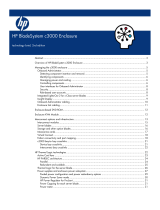
Abstract
This technology brief describes the HP strategy and long-term vision for logical servers to make a data
center infrastructure more adaptive. Products based on logical server technology will be implemented
in stages and released at the right time for the market.
Logical servers are a new class of abstracted servers that allows administrators to manage physical
machines and virtual machines using the same management construct. The logical server approach
enables administrators to plan, deploy, move, adjust, and manage server instances in their
environments regardless of how the logical server is created.
A logical server is defined by a server profile that is easily created and moved across physical and
virtual machines. A logical server profile includes the definition of the system services and resources—
whether these services and resources are virtual, physical, shared, or unshared—everything that the
operating system (OS) and application stack for a given workload require to operate. The logical
server profile is managed in software and can be applied to the creation of a virtual machine (VM)
using software-layer abstraction (hypervisor technology as the VM host) or to a physical machine (PM)
using physical-layer abstraction (HP Virtual Connect technology as the PM host).
Logical servers simplify routine administrative operations and processes and make the data center
more efficient. The logical server also enables flexibility and adaptability of the application/OS
workload without impacting shared network and storage domains.
This technology brief is intended for readers who are familiar with existing server virtualization
technology such as virtual machine software. For additional information about virtual machine
software, see the technology brief titled: “Server virtualization technology for the x86-based HP
BladeSystem and ProLiant servers,” available at
http://h20000.www2.hp.com/bc/docs/support/SupportManual/c01067846/c01067846.pdf.
The appendix contains a brief description of HP Virtual Connect technology for readers that are not
familiar with the technology.
Introduction
Virtualization in general, regardless of how it is implemented, uses some level of abstraction to allow
resources to be pooled and shared so that applications are more loosely coupled to underlying
hardware. As a result, IT administrators using virtualization have the ability to adjust resources based
on workload or location, so IT supply can more easily meet the dynamic needs of business.
Virtualization allows administrators to divide resources as needed and to set rules that reallocate
resources where and when needed, based on business priorities.
IT administrators are increasingly turning to server virtualization technologies such as virtual machine
software to provide flexibility and operational efficiencies in the data center. Virtual machine
technology is a powerful capability that can reduce costs and power use while improving resource
utilization. Since virtual machines can be easily moved from one server to another, they provide a
greater level of flexibility than traditional physical servers. However, not all applications are well-
suited for virtual machines today, particularly those with high I/O or deterministic latency
requirements.
Server virtualization technologies can be applied in other parts of the IT stack to deliver flexibility and
operational efficiencies. A powerful example is HP Virtual Connect, which abstracts connections from
servers to network and storage resources.
Through the concept of logical server abstraction, HP is bringing Virtual Connect, virtual machine,
and integrated management technologies together so IT administrators can create and manage virtual
machines and physical machines in the same manner throughout the lifecycle of a server. The logical
server approach is a key component for the HP Adaptive Infrastructure strategy. Through logical
2











